
Explore Esquimalt
Check out our comprehensive guide to exploring the area, grabbing groceries, whale watching and much more!
-

EAGLE WING TOURS
Located at the historic Fisherman's Wharf, Eagle Wing provides multiple departures daily and a peak season success rate of over 95%, they consistently provide the wildlife experience of a lifetime for environmentally conscious travelers from around the globe.
Resort guests are eligible for 10% off select tours. Please inquire with our reservations team!
-

PRINCE OF WHALES
Departing from the heart of Downtown Victoria, Prince of Whales offers unforgettable marine and wildlife adventures. Recognized by the BC Green Business as Certified Green & Ocean-Friendly and holding prestigious Biosphere certification and climate-positive status, Prince of Whales is dedicated to sustainability. Operating for over 30 years, they're committed to conservation as a proud member of 1% for the Planet.
Resort guests are eligible for 10% off Half-Day Whale watching and Sunset Whale Watching.
-

VICTORIA HARBOUR FERRY
See for yourself why Victoria Harbour Ferry is one of the city’s most treasured attractions. The water taxi is available for trips to town just steps away from our resort!
What’s local?
-

RESTAURANTS
La Belle Patate
Spinnakers
Esquimalt Roasting Company
The Esquimalt Bake Shop -

ECO-TOURS
Eagle Wing Tours (Whale and Wildlife)
Prince of Whales
Victoria Harbour Ferry -

ATTRACTIONS
Parliament
Macaulay Point Park
Saxe Point Park
Songhees Walk Way
Craigdarroch Castle
Art Gallery of Greater Victoria
Abkhazi Gardens & Government House
Fisherman’s Wharf
Buchart Gardens
Canada’s Oldest Chinatown -

SHOPPING
Salish Gift Shop
Government Street
The Bay Centre
Rogers' Chocolates (1903 store)
Lower Johnson Street
-
GROCERIES NEARBY
There are many grocery stores close by to find the exact ingredients you need to make a delicious meal. Check out some of our favorites below.Country Grocer -1153 Esquimalt Rd
Red Barn Market - 1310 Esquimalt Rd
Save on Foods - 172 Wilson St
The Market Garden - 810 Catherine St
Esquimalt Farmers’ Market - Thursdays seasonal (summer hours 4:30-7:30pm)
-
GROCERY DELIVERY
Save your valuable time and check out Thrifty's and Save On Foods quick and easy Online Shopping Service. Just pick what you want and they will select your groceries exactly how you like them. For an organic grocery option, Spud offers excellent produce and other ingredients that are guaranteed GMO and pesticide free. Your order will be delivered by professional drivers in a refrigerated, food safe truck.
Learn more at thriftyfoods.com/shop-online
Learn more at www.saveonfoods.com
Learm more at spud.ca
-
MEDICAL SERVICES
Emergency Hospital
Victoria General Hospital: 1 Hospital Way
Royal Jubilee Hospital: 1952 Bay St
Walk-In Clinic
Esquimalt Medical Clinic: #3-1153 Esquimalt Rd
Pharmacy and Vitamins
Esquimalt Pharmasave: #3-1153 Esquimalt Rd (next door to the walk-in clinic)
The Vitamin Shop: 1212 Broad Street
-
PET HEALTH
Vic West Pet Hospital was voted Best in City both in 2019 and 2020! Walk-ins can be accommodated but appointments are preferred.
Find more information at vicwestpethospital.com.
WAVES
Westcoast Animal Veterinary Emergency Specialty Hospital is open 24 hours in case of emergency and we have had positive reviews from our RV guests about this veterinary clinic.
Find more information at wavesvet.com.
-
WEST SONG WALKWAY
The name West Song Walkway is derived from “Songhees,” and “West Bay,” where the walkway ends. This boardwalk connects Esquimalt (from Head Street at West Bay Marina) to downtown Victoria (Johnson Street Bridge). The pathway is approximately 5 kilometres long and is a popular shoreline route for running, strolling, and commuting. Cycling is not permitted on the walkway.
-
VICTORIA HARBOUR FERRY
Renowned for its friendly skippers and water ballet, Victoria Harbour Ferry offers 45-minute Harbour Tours, 60-minute Gorge Cruises, and H20 Taxi hops. Escape the bustling downtown core and discover Victoria from the water. For H20 Taxi hops, look for the dockside "FERRY STOP" signs, hop onboard the next ferry, and tour the city one stop at a time. Harbour and Gorge tours start at the Causeway Marina and depart daily from March through October. Welcome aboard Victoria's friendliest tour.
There is a ferry stop conveniently located at the West Bay marina next door to our RV resort. See map below for Victoria Harbour Ferry stop location.
-
CYCLING
Esquimalt has designated bike lanes along Admirals Road, Esquimalt Road and Craigflower Road. CRD Bike Map
E&N (Esquimalt and Nanaimo) Rail Trail
The E&N Rail Trail is a paved regional multi-user pathway linking Victoria to the Western Communities through Esquimalt.Galloping Goose & Lochside Regional Trail*
Esquimalt offers easy access to the nearby Galloping Goose Regional Trail, a 55-kilometre multi-use trail connecting Victoria to Sooke.The Lochside Regional Trail is a 29-kilometre multi-use trail that connects Swartz Bay to Victoria and intersects with the Galloping Goose Trail.

Getting Here
Salish Seaside RV Resort and Marina
445 Head Street, Victoria BC V9A 5S1
-
From Up Island
Take the Highway #1 South. Exit at the McKenzie Avenue/Admirals Road interchange, follow Admirals Road south and turn left onto Lyall Street. Stay on Lyall Street, we are at the very end. -
When exiting the ferry terminal, turn left onto Belleville Street. Continue on Belleville until you merge onto Blanshard Street (Highway #17). Continue on Blanshard Street for around 6km and take exit #7 heading west on McKenzie Avenue. Once you cross the Trans-Canada Highway, McKenzie Avenue will turn into Admirals Rd. Continue until you hit Lyall Street and take a left. Stay on Lyall Street and we are at the very end.
-
Take the Patricia Bay Highway #17 South. Take exit #7 and turn right (west) onto McKenzie Avenue. Once you cross the Trans-Canada Highway, Mackenzie Avenue will turn into Admirals Rd. Continue until you hit Lyall Street and take a left. Stay on Lyall Street and we are at the very end.

